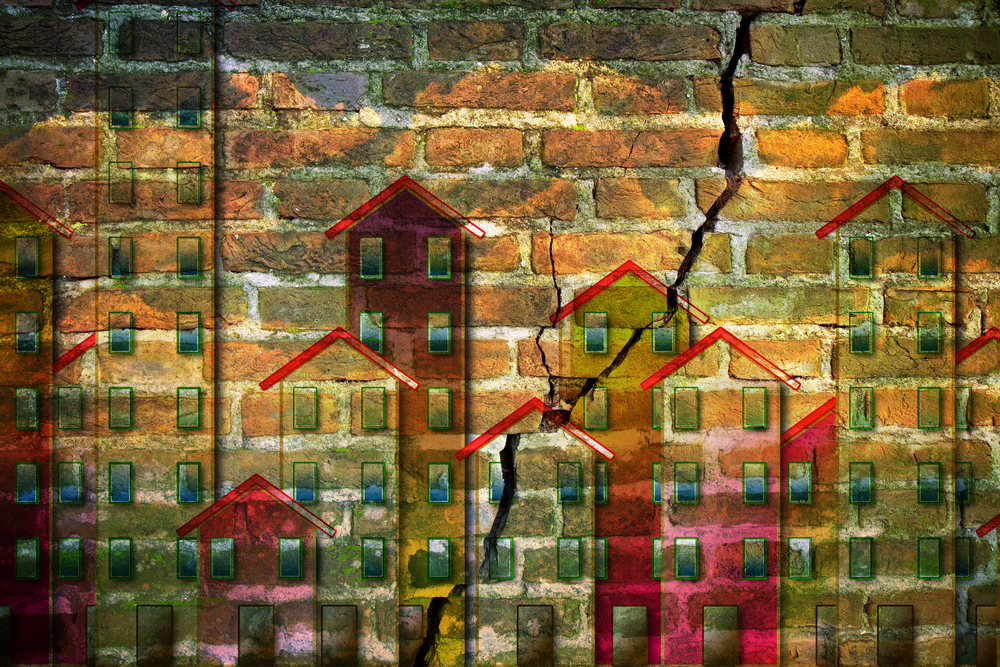Whether you are looking for a home, in the process of making a purchase or are already a homeowner - it's worth being aware of the signs of subsidence. Here's how to spot and prevent the problem
 Noticed a distinctive diagonal crack in the wall? Is your wallpaper peeling for no apparent reason? Or perhaps you have become frustrated with a sticking door or window?
Noticed a distinctive diagonal crack in the wall? Is your wallpaper peeling for no apparent reason? Or perhaps you have become frustrated with a sticking door or window?
There’s a chance if you are experiencing these problems that your home could be suffering the symptoms of subsidence – a structural event where the ground beneath your property sinks because the soil is unstable.
It’s something every homeowner dreads but, surprisingly, research suggests while one in five have noticed the signs as many as 26% don’t take action.
Now, insurer LV= is attempting to raise awareness of the red flags which could indicate subsidence is taking place in a bid to educate homeowners as well as potential buyers.
This is because cases of subsidence are increasing due to the hotter summers we are experiencing. Indeed, heatwaves make our homes more susceptible to the risks and, as such, LV= said claims soared last year and back in 2018 because of exceptionally hot years.
Fortunately, however, by spotting the signs early homeowners have more chance of rectifying the problem
Martin Milliner, claims director at LV= General Insurance said: “During the summer months, intense heat can affect our foundations and lead to subsidence, especially if your home is built on clay soil.
“Our research has found that many homeowners don’t fully understand the significant signs of subsidence, and we want to help consumers be confident enough to spot them at an early stage.
“It’s also a good idea to carry out any precautions on your home, as making small changes early on can help make a difference.
“From our research, we can also see that a high proportion of homeowners don’t know if their buildings insurance covers subsidence, and I’d encourage them to check so it’s not a potential costly problem in the future.”
What are the signs?
Some of the signs of subsidence are more obvious than others. Here are the main signs LV= has highlighted:
Distinctive diagonal cracks
These often appear at the edges of windows and doors and are usually wider at the top than the bottom and around 3mm thick or thicker than a 10p coin.
Doors or windows stick
If you notice a door or window sticking for no reason this could be a sign of subsidence. Another one to look out for isany doors or windows closing easily in winter but not summer.
Tearing wallpaper
This can often be caused by damp. However, if it’s happening in your home and you can find no evidence of damp, it could be subsidence.
LV= said there was much confusion when it surveyed the public over the signs to look out for. It has provided the table below to help you discern the true and false warning signs:
| TRUE | FALSE |
| Large cracks in walls (indoor and exterior) – 71% | Tilting large trees outside the home – 30% |
| Sinking foundations or sloping floors – 68% | Bulging floorboards – 28% |
| Sinking or dips in pathway or driveway – 53% | Damp patches appearing – 13% |
| Doors and windows difficult to open or stick – 48% | Signs of mould – 9% |
| Wallpaper tearing (with no signs of damp) – 25% | Musty odour – 8% |
(Source: LV=)
Tips to help prevent subsidence
Prune trees and large shrubs
This will prevent soil from drying out, LV= advises. You can always seek professional advice from a tree specialist if you need more help.
Check water pipes and guttering
Look for any leaks which can wash away or soften soil.
Lay porous materials around the home
Materials like gravel or grass, to allow water to drain naturally and help reduce subsidence.
What to do if you spot subsidence?
LV+ said, amongst those who had spotted signs of subsidence in their homes and took action, the most common response was to call their insurer (51%), while just over a fifth (22%) had professional checks undertaken by building surveyors.
For more information about spotting signs of subsidence and preventative measures, you can read LV=’s guide here.
LV= said cover for subsidence was included in its GI’s buildings insurance as standard. This included cover to rectify the damage and alternative accommodation should customers need to move out of their home while the work is carried out.
It’s always worth shopping around for the best home insurance deal which suits your budget and requirements. However, don’t’ forget to check whether subsidence is included in the policy.














